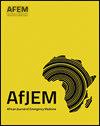Data completeness and quality of emergency triage in Ethiopian public tertiary hospitals: A multicenter study
IF 1.2
4区 医学
Q3 EMERGENCY MEDICINE
引用次数: 0
Abstract
Introduction
Triage is a system of ranking sick or injured persons according to their severity. Its data is critical for evidence-based action. The aim of this study was to assess the quality and completeness of emergency department triage tool in three tertiary Ethiopian public hospitals.
Method
This study utilized a multicenter cross-sectional design with sample size estimation calculated using a single population proportion formula. Data were collected from multiple sites and analyzed using the Statistical Package for the Social Sciences (SPSS), version 25. All statistical analyses were conducted to evaluate the completeness of triage documentation.
Result
In a review of 450 client charts from three tertiary hospitals providing acute care, the completeness of triage data varied. Patient name, age, and gender were documented with a completeness of 79.1 %, 77.5 %, and 70.8 %, respectively. The cumulative analysis of the triage early warning score showed, highest recorded completeness was for heart rate (98.4 %), followed closely by respiratory rate (96.0 %). However, significant discrepancies were noted in other areas, such as systolic blood pressure, which had an overall completeness of 87.7 %. Temperature assessment was notably poor, with a cumulative completeness of only 59.3 %. Other parameters, including mobility and AVPU/CNS assessments, showed completeness of 86.4 % each.
Conclusion
This study identifies significant inconsistencies in triage documentation completeness across three Ethiopian hospitals, highlighting an urgent need for interventions. Standardized triage scales and continuous professional development focusing on documentation are crucial to enhance patient safety and optimize care delivery.
埃塞俄比亚公立三级医院急诊分诊的数据完整性和质量:一项多中心研究
分诊是一种根据病人或伤者的严重程度对他们进行排序的制度。它的数据对循证行动至关重要。本研究的目的是评估埃塞俄比亚三所三级公立医院急诊科分类工具的质量和完整性。方法本研究采用多中心横断面设计,样本量估算采用单一总体比例公式。从多个站点收集数据,并使用社会科学统计软件包(SPSS),版本25进行分析。所有统计分析均用于评估分诊记录的完整性。结果通过对三家三级医院450例急诊病例的分析,发现分诊数据的完整性存在差异。患者姓名、年龄和性别记录的完整性分别为79.1%、77.5%和70.8%。分诊预警评分累积分析显示,心率记录的完整性最高(98.4%),其次是呼吸频率(96.0%)。然而,在其他领域,如收缩压,其总体完整性为87.7%,存在显著差异。温度评估明显较差,累计完成度仅为59.3%。其他参数,包括移动性和AVPU/CNS评估,均显示86.4%的完整性。结论:本研究确定了埃塞俄比亚三家医院在分类文件完整性方面存在显著不一致,强调了干预措施的迫切需要。标准化的分诊量表和持续的专业发展注重文件是至关重要的,以提高病人的安全和优化护理服务。
本文章由计算机程序翻译,如有差异,请以英文原文为准。
求助全文
约1分钟内获得全文
求助全文
来源期刊

African Journal of Emergency Medicine
EMERGENCY MEDICINE-
CiteScore
2.40
自引率
7.70%
发文量
78
审稿时长
85 days
 求助内容:
求助内容: 应助结果提醒方式:
应助结果提醒方式:


